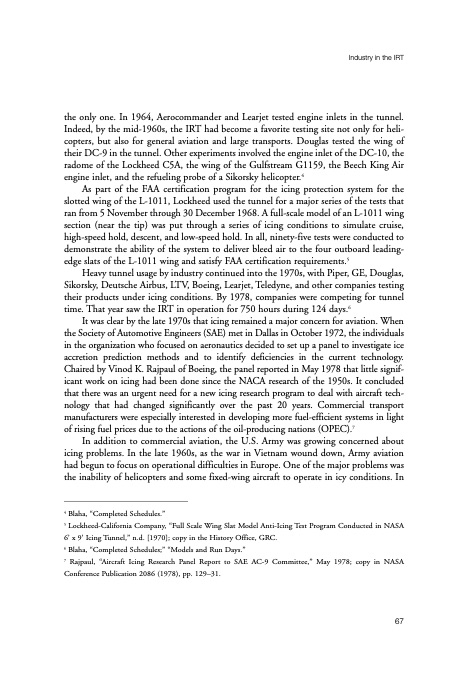
PDF Publication Title:
Text from PDF Page: 079
the only one. In 1964, Aerocommander and Learjet tested engine inlets in the tunnel. Indeed, by the mid-1960s, the IRT had become a favorite testing site not only for heli- copters, but also for general aviation and large transports. Douglas tested the wing of their DC-9 in the tunnel. Other experiments involved the engine inlet of the DC-10, the radome of the Lockheed C5A, the wing of the Gulfstream G1159, the Beech King Air engine inlet, and the refueling probe of a Sikorsky helicopter.4 As part of the FAA certification program for the icing protection system for the slotted wing of the L-1011, Lockheed used the tunnel for a major series of the tests that ran from 5 November through 30 December 1968. A full-scale model of an L-1011 wing section (near the tip) was put through a series of icing conditions to simulate cruise, high-speed hold, descent, and low-speed hold. In all, ninety-five tests were conducted to demonstrate the ability of the system to deliver bleed air to the four outboard leading- edge slats of the L-1011 wing and satisfy FAA certification requirements.5 Heavy tunnel usage by industry continued into the 1970s, with Piper, GE, Douglas, Sikorsky, Deutsche Airbus, LTV, Boeing, Learjet, Teledyne, and other companies testing their products under icing conditions. By 1978, companies were competing for tunnel time. That year saw the IRT in operation for 750 hours during 124 days.6 It was clear by the late 1970s that icing remained a major concern for aviation. When the Society of Automotive Engineers (SAE) met in Dallas in October 1972, the individuals in the organization who focused on aeronautics decided to set up a panel to investigate ice accretion prediction methods and to identify deficiencies in the current technology. Chaired by Vinod K. Rajpaul of Boeing, the panel reported in May 1978 that little signif- icant work on icing had been done since the NACA research of the 1950s. It concluded that there was an urgent need for a new icing research program to deal with aircraft tech- nology that had changed significantly over the past 20 years. Commercial transport manufacturers were especially interested in developing more fuel-efficient systems in light of rising fuel prices due to the actions of the oil-producing nations (OPEC).7 In addition to commercial aviation, the U.S. Army was growing concerned about icing problems. In the late 1960s, as the war in Vietnam wound down, Army aviation had begun to focus on operational difficulties in Europe. One of the major problems was the inability of helicopters and some fixed-wing aircraft to operate in icy conditions. In Industry in the IRT 4 Blaha, “Completed Schedules.” 5 Lockheed-California Company, “Full Scale Wing Slat Model Anti-Icing Test Program Conducted in NASA 6’ x 9’ Icing Tunnel,” n.d. [1970]; copy in the History Office, GRC. 6 Blaha, “Completed Schedules;” “Models and Run Days.” 7 Rajpaul, “Aircraft Icing Research Panel Report to SAE AC-9 Committee,” May 1978; copy in NASA Conference Publication 2086 (1978), pp. 129–31. 67PDF Image | History of NASA Icing Research Tunnel

PDF Search Title:
History of NASA Icing Research TunnelOriginal File Name Searched:
sp4226.pdfDIY PDF Search: Google It | Yahoo | Bing
NFT (Non Fungible Token): Buy our tech, design, development or system NFT and become part of our tech NFT network... More Info
IT XR Project Redstone NFT Available for Sale: NFT for high tech turbine design with one part 3D printed counter-rotating energy turbine. Be part of the future with this NFT. Can be bought and sold but only one design NFT exists. Royalties go to the developer (Infinity) to keep enhancing design and applications... More Info
Infinity Turbine IT XR Project Redstone Design: NFT for sale... NFT for high tech turbine design with one part 3D printed counter-rotating energy turbine. Includes all rights to this turbine design, including license for Fluid Handling Block I and II for the turbine assembly and housing. The NFT includes the blueprints (cad/cam), revenue streams, and all future development of the IT XR Project Redstone... More Info
Infinity Turbine ROT Radial Outflow Turbine 24 Design and Worldwide Rights: NFT for sale... NFT for the ROT 24 energy turbine. Be part of the future with this NFT. This design can be bought and sold but only one design NFT exists. You may manufacture the unit, or get the revenues from its sale from Infinity Turbine. Royalties go to the developer (Infinity) to keep enhancing design and applications... More Info
Infinity Supercritical CO2 10 Liter Extractor Design and Worldwide Rights: The Infinity Supercritical 10L CO2 extractor is for botanical oil extraction, which is rich in terpenes and can produce shelf ready full spectrum oil. With over 5 years of development, this industry leader mature extractor machine has been sold since 2015 and is part of many profitable businesses. The process can also be used for electrowinning, e-waste recycling, and lithium battery recycling, gold mining electronic wastes, precious metals. CO2 can also be used in a reverse fuel cell with nafion to make a gas-to-liquids fuel, such as methanol, ethanol and butanol or ethylene. Supercritical CO2 has also been used for treating nafion to make it more effective catalyst. This NFT is for the purchase of worldwide rights which includes the design. More Info
NFT (Non Fungible Token): Buy our tech, design, development or system NFT and become part of our tech NFT network... More Info
Infinity Turbine Products: Special for this month, any plans are $10,000 for complete Cad/Cam blueprints. License is for one build. Try before you buy a production license. May pay by Bitcoin or other Crypto. Products Page... More Info
| CONTACT TEL: 608-238-6001 Email: greg@infinityturbine.com | RSS | AMP |